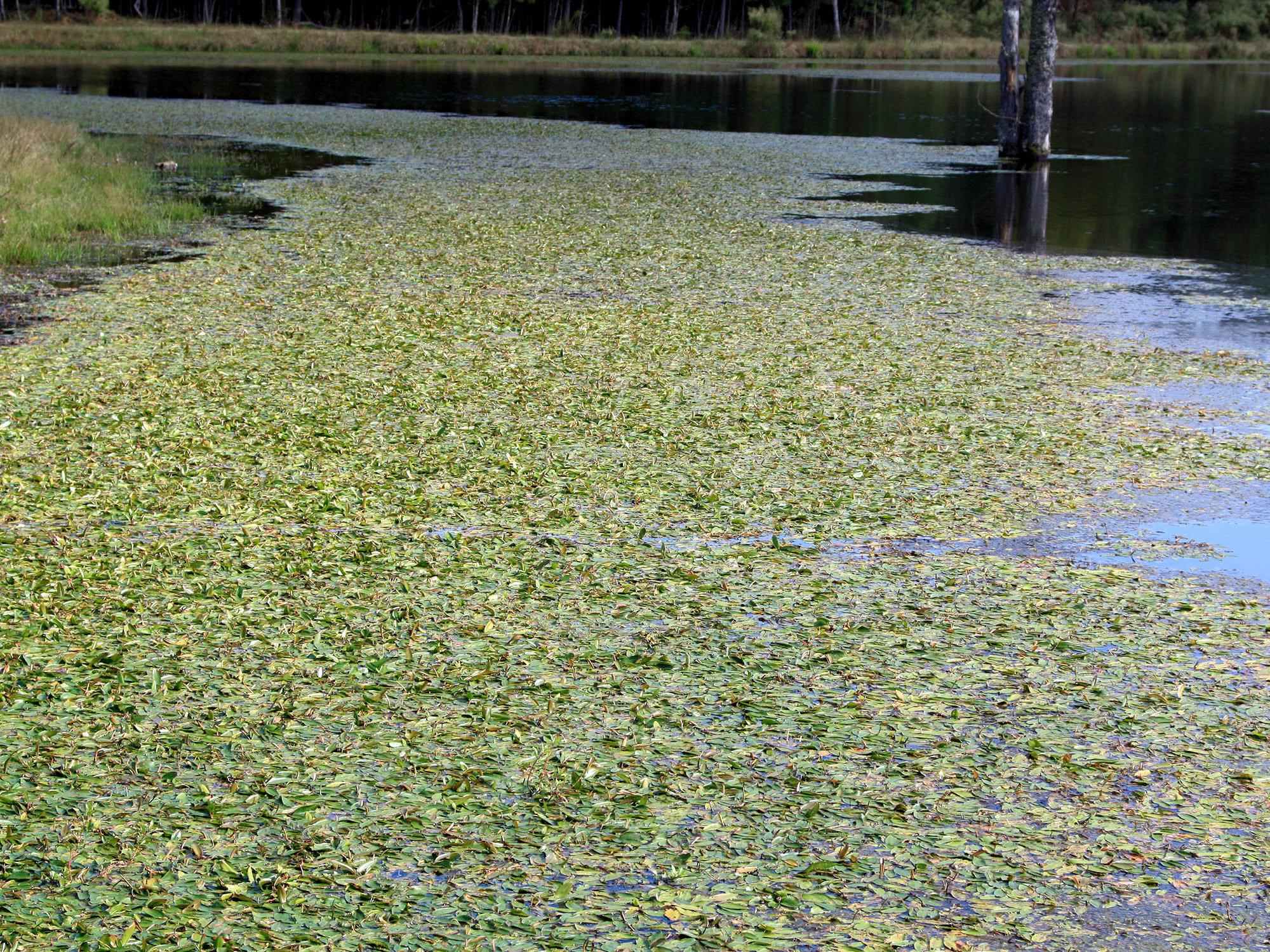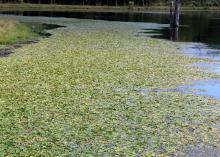Information Possibly Outdated
The information presented on this page was originally released on April 25, 2014. It may not be outdated, but please search our site for more current information. If you plan to quote or reference this information in a publication, please check with the Extension specialist or author before proceeding.
Get a head start on pond weed problems
The birds are singing, the flowers are blooming, and yes, the weeds are starting to grow in your fishing pond. Don’t let them get out of hand! Start your weed management program early, before the problem becomes too difficult to treat.
Prevention is the best way to avoid weed problems. Shallow areas where light reaches the pond bottom are ideal for the growth of rooted aquatic weeds. Deepening pond edges so that the water depth quickly reaches 3 feet helps reduce weeds. For safety, make the slope 3:1, or one foot deeper for every three feet farther from shore.
Another way to prevent rooted weeds from growing is by fertilizing the water to stimulate the production of microscopic plants that shade the pond bottom. Ponds with existing weed problems should not be fertilized, as this will only stimulate the growth of the weeds. Fertilization is not a good option for stock watering ponds.
To help prevent weeds from becoming established, stock triploid grass carp at about five fish per acre in new or weed-free ponds.
Too many or too few nutrients can lead to weed growth. Excess nutrients from livestock or other sources can run off into a pond and lead to weed problems, especially algae. Duckweed and watermeal also thrive in nutrient-rich waters, especially in dry winters when ponds are not flushed out by rainwater.
Prevention is always the best approach, but if weeds do become a problem, the first step in weed control is to identify the problem weed or weeds. The most effective control measures vary with the kind of plant, so be sure to identify the plant accurately. Your local MSU Extension Service office can help with identification, and there are several good online resources available.
Once you know the weed, there are four forms of weed control: physical, mechanical, biological, and chemical. These control measures are usually most effective when combined.
Physical control may include using pond dyes to shade out plants, adding liners to prevent rooting, or deepening the pond edges. Pond dyes are often not effective, and liners can be prohibitively expensive. Pond deepening, however, is a good, long-term solution to many weed problems.
Mechanical control includes cutting or pulling plants. It is possible for small ponds or isolated patches of weeds, but weeds that are cut often grow back and have to be cut again. Also, some plants can form new plants from small fragments, so disturbing these plants may make matters worse. Floating weeds often are blown into a corner of the pond, where they can be scooped out with a fine mesh net.
Biological control, such as adding grass carp, is effective for some types of aquatic weeds. Grass carp prefer tender, succulent vegetation submerged in the water, such as hydrilla, pondweed and naiad. They will not control tough, fibrous plants that grow up out of the water, such as alligatorweed and cattails. Other types of weeds may or may not be eaten by grass carp, depending on how hungry the fish become, and results may not be predictable.
Chemical control of aquatic weeds is the last resort in weed management. Spot treatments of weedy areas usually can be accomplished without problems, but when whole-pond treatments are required, accurate measurement of the pond area is important. Visually estimating the area of a pond is quite difficult, even for “experts,” but it is necessary to get an accurate estimate so that herbicide dosage can be calculated correctly.
The best time to treat aquatic weeds with herbicide is during the spring when the plants are growing rapidly and water temperatures are cooler, around 70 to 80 degrees.
Decomposition of weeds killed by herbicides removes oxygen from the water and can even result in a fish kill, especially in the summer months. When using a fast-acting herbicide, treating only a section at a time -- up to a third of the pond area -- will reduce the chances of oxygen problems. Unless the herbicide is intended for whole pond application, treating only a portion of the weeds at a time allows affected weeds to decompose before the next application.
Mississippi State Extension publication 1532, “Weed control guidelines for Mississippi,” provides the latest information on approved herbicides and which plant species they control, as well as use restrictions and other valuable information.

Editor’s Note: Extension Outdoors is a column authored by several different experts in the Mississippi State University Extension Service.




